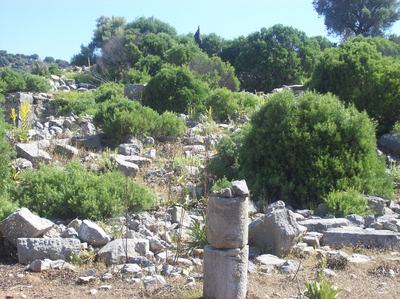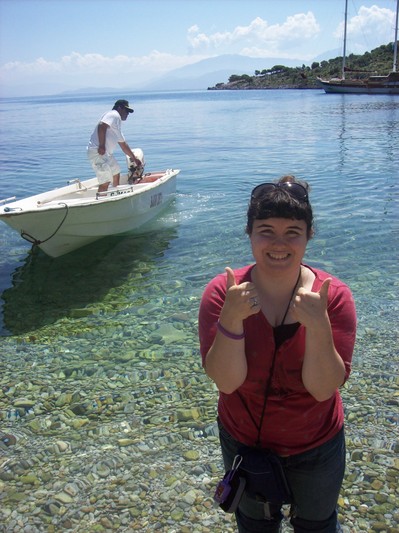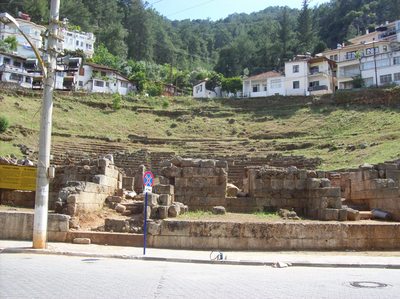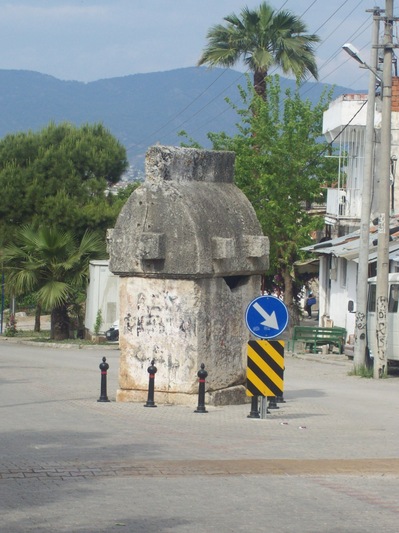Today we hiked up from the beach near our gulet to an unexcavated Lykian site near a shepherd’s house. The hike was rather hard for me because I am not in the best physical shape, so I was at the back of the pack with Captain Talet (who took my bag from me and is in the picture of me in the Mediterranean) the whole way up. We saw an old tomb, a few old buildings, and a water hut. We then visited the shepherd and his family, who served us sage tea and let us browse their merchandise. I bought a purple rug for 15 lira and a black scarf with shells for 10 lira. It was a quaint, rustic place that reminded me of home. On the way back (which was MUCH easier than the way there) I talked with Professor Killebrew about my family. The Mediterranean was a beautiful turquoise and was as warm as normal pool. One of the sailors on our gulet went diving and brought up shells and sea urchins, of which I took 2. I then ate lunch, packed my bags (fitting all of my souvenirs into my second carry-on), and sat out in the sun with a few others for most of the trip to Fetiye.
We tried to help the sailors load our things onto the dock, but we ended up watching from the bottom until Mr. Attila arrived with our bus. We waved goodbye to the sailors, loaded our luggage, and then set off into the city center to see the Telemos Theatre. We made this our meeting point, and then Jo and I went to look for lamps. We found a slightly expensive store that sold them, and I bought a purple glass candle holder and a tiny tapestry with the flag of Turkey and an evil eye on it for a total of 24 lira, while Jo only bought one beaded glass candle holder for 19 lira. We then got ourselves Magnum Double Chocolate Ice Cream Bars and met up with everyone else at the Theatre before setting off for Cayake/Levassi.
We learned on the way up that Fetiye was named after the first pilot, who was born here and died. It has 2 harbors, the commercial harbor we came in and the “blue lagoon” harbor that we are staying at for the rest of our trip. We saw an old Lykian tomb in the middle of the road on the way up and found out that Ottomans built around it and through the old Telemos necropolis. We continued our journey and learned that Levassi was an old Greek town that had been cleared out in 1923 by Ataturk and the president of Greece’s mubadel or population exchange after the First World War and the Turkish Revolution in order to keep peace in both countries. But these Greek Turks and Turkish Greeks were not happy to move from what they viewed as their homeland, and this is reflected in works such as “Birds without Wings” and in the neighborhood of Athens named after Levassi.
Levassi is now an open-air museum with the majority of the buildings abandoned except for a few villas owned by some Brits. Near the vendors, Kelly found a pile of ceramics, rusted iron pieces, and other things left behind by the former residents that we both took pictures of. The hike up to the 17th Century Church was filled with beautiful but old, rundown brick homes. At the church, whose stone mosaic was still mostly preserved outside, we learned that Levassi had its own school, religious system, small hospital, and imc or communal construction system 8 km from the Mediterranean. I found this site to just be sad. I have read “Middlesex” with talks a little about the population exchange and all of the lives lost in Smyrna, and I wondered what it must be like to have to move from the only place you have only know, where your parents, grandparents, and great-grandparents lived and died to a land that you barely know of but is your ethnically correct home to be in. It is a lot like what the United States Government did to Native American tribes in the 1800’s in order to get prized land and to control them, and moving populations like that does not agree with me. I understand that in the Turkish/Greek case it was to maintain order, but if these populations were not causing trouble with the opposite population then they should have been allowed to stay.
Fact of the day:
Fetiye is one of the greatest places to paraglide in the world.
Location: Fetiye, Turkey
Loading map...









